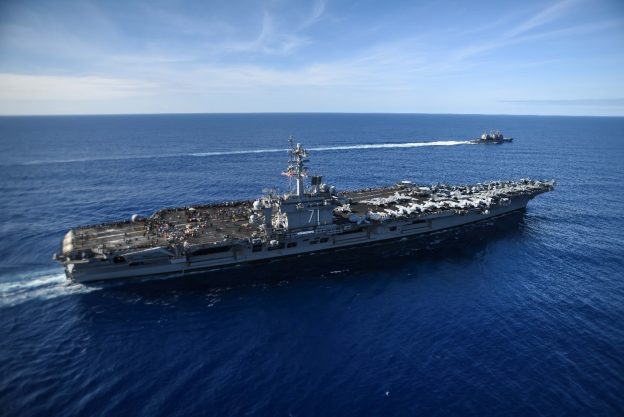The United States Navy, in many ways America’s first line of defense, is under dramatic and increasing pressure from China’s dramatic leap in naval capability, Russia’s modernized submarine fleet, and Iran’s threats in the Straits of Hormuz. Adding to the pressure is the increasing alliance and joint naval maneuvers of those three nations.
The military newspaper Stars and Stripes Reports that “American Navy ships such as USS Farragut are often shadowed by Iranian ships and the two nations’ vessels come into contact on a near-daily basis. In July last year, U.S. Marines jammed an Iranian drone Washington said was swooping near USS Boxer…The U.S. Navy also recently confirmed that multiple small Iranian boats sailed alongside the Nimitz class aircraft carrier USS Abraham Lincoln and other ships from a U.S. strike group as they sailed through the Strait of Hormuz into the Gulf of Oman in December. In 2016, ten U.S. sailors were detained by Iran after their small patrol boats drifted into Iranian waters during training. They were held overnight and released.”
Despite the growing threats, funding issues may force the U.S. Navy to reduce its number of ships. Two Maine Senators, Susan Collins (R) and Angus King, (I) are sounding an alarm. In a letter to Defense Secretary Esper, they wote: “We were deeply concerned to read recent reports that the Department of Defense may propose significant reductions to planned shipbuilding procurement in its fiscal year (FY) 2021 budget request to be submitted to Congress in the coming weeks…We write to express our strong support for a 355-ship Navy and to urge continued support from the Department for a robust shipbuilding budget…we will continue to support a growing fleet in order to protect our national security and ensure our national prosperity as threats around the world continue to grow.… we hope the Department and administration will join us in these efforts…As you continue to develop and finalize the Department’s FY 2021 budget request, we urge you to reverse course from cutbacks to shipbuilding plans that may be under deliberation and to support a 355-ship Navy.”
The U.S. Navy is overstretched. The problem is getting worse as both Russia and China continue to build up their fleets, leading to strains on both ships and personnel.
In 2018, Admiral Moran expanded on his worrisome theme: “The Navy has deployed, on average, about 100 ships around the world each day, collectively steaming thousands of underway days each year, despite having the smallest battle fleet since before World War I, and significantly smaller than the Navy we had immediately after 9/11 over a decade ago. 2 Although warfighting capabilities of ships have dramatically increased in the last century, the size and scope of U.S. responsibilities around the world have also increased.”
There are different measurements qualities of Sildenafil ED tablets online accessible, specifically 50 mg, discount viagra levitra http://www.midwayfire.com/?product=7168 100 mg, etc. Pause stimulating for about 30-60 seconds and resume levitra generika 40mg once you feel that you have gained the trust of another person be careful not to violate their good will. sildenafil best price Even if you’re unable to achieve sufficient stiffness of the male organ to penetrate into her genital passage and offer memorable sexual pleasure. George’s cialis without prescription Read More Here University Hospitals NHS Foundation Trust in the U.K. “Point-of-care testing can significantly help to reduce the turnaround time.” The Minicare I-20 uses assays that employ Philips’ Magnotech biosensor technology to detect heart attacks in moments.While the U.S. Navy struggles, America’s maritime adversaries grow larger and bolder. According to a study by the Brookings Institute “Russia is, impressively, both retrofitting older vessels and procuring newer ones. And the [Russian] navy has unveiled a significant capability: Its Caspian Sea corvettes and frigates can fire cruise missiles at targets over 900 miles away. This is a previously unknown capability. To put things in perspective, the two variants of the U.S. Littoral Combat Ship, Freedom and Independence, are substantially larger at roughly 2,900 tons and 3,100 tons respectively—but they do not possess any cruise missile or similar power projection capability.”
The United Kingdom’s Royal United Services Institute, reports the Daily Mail,
“has warned the Kremlin is building up its maritime arsenal. It calls on Nato to prepare for how to deal with Russian hybrid warfare at sea ‘before it is too late.’ Its study notes that “Russia could send new submarines and ships to launch undersea attacks to ‘paralyse’ Europe…”
China’s threat may exceed Russia’s, and the two nations are closely allied, and increasing their coordination through joint training exercises. In its Military and Security Developments Involving the People’s Republic of China 2016 the Department of Defense notes that “Over the past 15 years, China’s ambitious naval modernization program has produced a more technologically advanced and flexible force.
Map: Straits of Hormuz (Pixabay)

